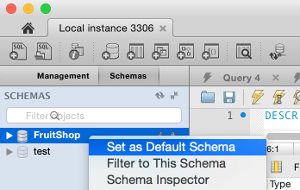MySQL Default Database
Here's the means by which to set a default database for every single consequent question.
MySQL enables you to set a default database to be utilized as the setting for any consequent SQL proclamations. There could be numerous databases on the server and MySQL has to know which database you need any SQL explanation/s to be kept running against. Setting a default database is a decent begin as it spares you from determining the database in the inquiry.
You can change the default DB as regularly as you like. It's not really a {"set and overlook"} thing. Contingent upon what number of databases you're working with, you could be exchanging the default DB as often as possible.
You can set the default database either automatically or by means of the graphical interface.
Utilizing the MySQL Workbench GUI

Right-click on the database name in the SCHEMAS tab (in the left menu):

Screen capture of setting the default database by means of the MySQL Workbench GUI
The default database will presently be recorded in an intense typeface:
Screen capture of the default DB (recorded in striking)
Automatically
The USE articulation advises MySQL to utilize a specific database as the default when you run ensuing SQL proclamations.
USE FruitShop;
Presently any consequent questions will be kept running against the FruitShop DB. Like this:
{`
USE FruitShop;
SELECT * FROM Fruit;
`}
The CREATE DATABASE Script
The USE proclamation can truly prove to be useful in our contents that make databases. When we've made our database, we can set it as the default database by determining the USE articulation against it.
Doing this will guarantee that any ensuing SQL explanations will utilize our recently made database as the present DB (except if indicated generally in the content). This is significant on the grounds that it reveals to MySQL which DB to make the tables against:
{`
DROP DATABASE IF EXISTS FruitShop;
Make DATABASE FruitShop;
USE FruitShop;
Make TABLE table_1 (...);
Make TABLE table_2 (...);
`}
Exchanging the Default Database
There's nothing to stop you exchanging the default database on various occasions inside your contents. So, on the off chance that you had two databases, you could accomplish something like this:
{`
USE FruitShop;
SELECT * FROM Fruit;
USE VegeShop;
SELECT * FROM Vegetables;
`}
The above question chooses all records from the Fruit table in the FruitShop database and all records from the Vegetables table in the VegeShop database. Without the USE proclamation, MySQL wouldn't know which database to inquiry for every announcement.
Obviously, this is a rearranged model. Regularly you'll wind up accomplishing increasingly complex inquiries against your databases and this strategy can truly help.
Qualifying the DB Name in the Statement
Despite whether you set a default database, you can likewise determine the database inside the announcement. To do this, utilization the accompanying sentence structure: database.table.column
Here's a model:
{`
SELECT FruitName, VegeName FROM FruitShop.Fruit, VegeShop.Vegetables
WHERE FruitShop.Fruit.SupplierId = VegeShop.Vegetables.SupplierId ;
Abrogate the Default DB — Specify the Database inside a Query
`}
Setting a default database doesn't block you from questioning different databases. Indeed, even after you've set a default database, you can at present question different databases without setting them as a default. You can at present determine which database to use inside your inquiries. Truth be told, you can utilize different databases inside a solitary question utilizing this technique.
So, the above model could likewise be composed as pursues:
{`
USE FruitShop;
SELECT FruitName, VegeName FROM Fruit, VegeShop.Vegetables
WHERE Fruit.SupplierId = VegeShop.Vegetables.SupplierId ;
USE FruitShop;
SELECT FruitName, VegeName FROM Fruit, VegeShop.Vegetables
WHERE Fruit.SupplierId = VegeShop.Vegetables.SupplierId ;
`}
MYSQL Tutorials
- Create MySQL Database
- Create Table in MySQL
- Insert data to MySQL
- Mysql Queries
- Update data in MYSQL
- Delete data in MySQL
- Default Database
- Primary Key
- Foreign Keys
- Views
- Export MySQL Database
- Import data into Mysql
- Create Website with MySQL
MYSQL Sample Assignments
- COIT20247 Database Design and Development
- Relational schema and MySQL database
- Mysql Project
- ITICT107A Introduction to Databases
- MySql Assignment Question
MYSQL Sample Solutions
- Solution - COIT20247 Database Design
- Solution - Relational schema and MySQL
- Solution - Mysql Project
Testimonials
Very affordable projects!! And that to submit before deadlines. Thanks for helping me in my database project and raising my grades. I have been able to secure good marks in my internal assessment only because of you. Read More

